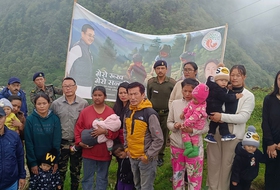
Several hundreds of women in India have rejuvenated vast stretch of forest land through a unique method of guarding the forest.
8 centimetres since 1992. This is how much sea levels have risen due to ice melting and warming oceans. “It’s very likely to get worse”.
IPCC’s estimates probably resulted too reasonable. That’s what NASA researchers affirmed last Wednesday in a conference, when they claimed that sea levels have risen 8 centimetres since 1992, way faster than registered over the last 50 years.
And “it’s very likely to get worse”, said Steve Nerem, geophysicist at the University of Colorado. The causes: climate change, melting ice, and warming oceans. “Significant changes are taking place today on ice sheets,” reports the Guardian, quoting the words of Eric Rignot, a glaciologist at the University of California in Irvine. “It would take centuries to reverse the trend of ice retreat.”
It’s not about catastrophism, nor unavoidability, but acknowledging that we are going through a change in our planet’s surface, and that it’s necessary to plan adaptation activities, particularly for people living along the coasts. “We have data you can now use to estimate what the impacts are going to be in the next 100 years,” said Tom Wagner, NASA scientist.
The scientist, as reported by RTTC News, explained how sea levels could rise 3 metres by the end of the century, if ice melts rapidly. “We’re seeing evidence that the ice sheets are waking up, but we need to understand them better before we can say we’re in a new era of rapid ice loss.”
Meanwhile, last Monday, the ESA has spotted one of the largest icebergs ever seen, off the coast of Greenland, with a surface equal to the entire island of Manhattan.
Siamo anche su WhatsApp. Segui il canale ufficiale LifeGate per restare aggiornata, aggiornato sulle ultime notizie e sulle nostre attività.
![]()
Quest'opera è distribuita con Licenza Creative Commons Attribuzione - Non commerciale - Non opere derivate 4.0 Internazionale.
Several hundreds of women in India have rejuvenated vast stretch of forest land through a unique method of guarding the forest.
The solution developed by the Italian startup Agri-E enables on-site bioethanol production, promoting energy self-sufficiency for farms.
South African court dismisses a major lawsuit by 140,000 Zambian women and children against Anglo American for Kabwe lead poisoning. A setback for affected communities enduring the lasting impact of lead contamination.
Controversial African land deals by Blue Carbon face skepticism regarding their environmental impact and doubts about the company’s track record, raising concerns about potential divergence from authentic environmental initiatives.
Majuli, the world’s largest river island in Assam State of India is quickly disappearing into the Brahmaputra river due to soil erosion.
Food imported into the EU aren’t subject to the same production standards as European food. The introduction of mirror clauses would ensure reciprocity while also encouraging the agroecological transition.
Sikkim is a hilly State in north-east India. Surrounded by villages that attracts outsiders thanks to its soothing calmness and natural beauty.
Sikkim, one of the smallest states in India has made it mandatory for new mothers to plant saplings and protect them like their children to save environment
Chilekwa Mumba is a Zambian is an environmental activist and community organizer. He is known for having organized a successful lawsuit against UK-based mining companies.







